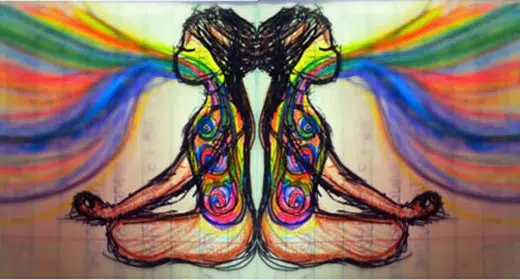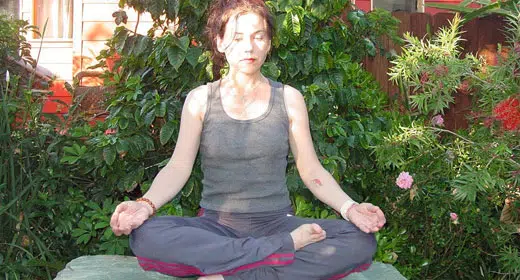by Donna Quesada: Deliberately Versus Reactively—

I remember one particular weekend in Yoga training, when we worked intensely with our breath… We partnered up and inhaled against each other’s hands, as our partner pressed against our diaphragm. Then while sitting up facing each other, we did the “one minute breath,” in which you inhale for 20 seconds, hold for 20 seconds, and then exhale for 20 seconds.
In addition, we completed a kriya for anger, in which we deliberately hit the floor and made our faces angry. I remember thinking of my Italian grandma, who would tell me, whenever I got frustrated about anything, “don’t make your face like that or you’ll make yourself ugly.” In this case, we were deliberately making our faces like that, as a group!
The difference between doing it deliberately versus reactively, is the consciousness that suffuses it. When done purposefully, it is entirely conscious and the anger generated is therefore, constructive, rather than destructive.
But even more… It creates a magical and lasting shift deep within your psyche because you are the one in the driver’s seat. You are the one in control. You are the one doing it. You are the one choosing it.
The Tough Part of The Kriya—
One of the other breath exercises we did, was in the context of a kriya, which, in our kundalini training, usually refers to a sequence of postures, breath, and mantra, that together, culminate in a specific outcome. For example, a kriya may be structured around the goal of aleviating anger or anxiety. In some cases, a kriya may only include one single posture, in conjunction with certain breathing stipulations or hand positions, known as mudras. The idea is that done, together, the elements of the kriya make the exercise more powerful than when done alone.
Because a kriya generates certain shifts with the body, the mind and the spirit simultaneously, it requires total presence, even when you feel you can’t continue on for even one more minute. In other words, it invites you to experience the discomfort, the antsy-ness, the impatience, the wiggly-ness, and the desperation to move… to get up… to lie down… but especially, to stop.
For me, this was especially true with the kriya that asked us to hold our breath for as long as possible. For anxious types and worriers, thoughts take on all sorts of despairing forms, What if I pass out… What if I die? But, you continue to sit with it. Just watch the worry loop. In fact, one trick I learned to employ was to “do the opposite.” In this case, when you’re dying to EXHALE, you INHALE… even more. When you think you can’t hold your breath in any longer, you take in even more, rather than let it out. You sit with it even longer than you thought you could.
The Elements That Make It Work—
Part of what makes this such a powerful exercise is firstly, that you are sitting with it consciously and deliberately, and secondly, that you’re the one who is (deliberately) doing it. You’re the one in charge. You’re the one who chose this experience. And you remind yourself of this fact, as needed.
Sitting with the experience consciously, means that you’re willfully present in the experience to experience the experience.
The idea is that in the real world, so to speak, you get better at sitting with uncomfortable experiences. And in the real world, you can trick your mind into thinking that you have chosen those experiences too, just as you chose to hold your breath longer than what was comfortable.
A Variation of “Act As If”—
This is a version of the Zen teaching to act as if… Act as if you have chosen it. Because at least on the mat, you have.
The point is not necessarily to “beat your time,” and win the breath-holding contest. Although you probably will beat your time, the more you do it. The point is to experience the discomfort and to stay with it. And then one step further… to experience the internal shift that naturally occurs, when you tell yourself a different story… that you have chosen this experience.
Through this practice, the old storyline loses its control over you—it no longer “has you by the nose,” as my Zen master used to say. A kind of internal strength is generated. There’s a magical turnaround that happens when you put yourself in the driver’s seat, to the extent that the sense of angst that usually goes along with discomfort, begins to withdraw.

Give it a try—
Try holding your breath with the stopwatch on your phone, and see how long you can go. Then try it again, while adding the other elements of the practice while you do it, and see what internal shifts occur, the second time around…
As you begin to experience a bit of discomfort… usually at some point after the 45 second mark… add the elements that make for a new story… things along these lines:
Your Inner Dialogue—
I am, right NOW, experiencing what I feel… I’m experiencing my chest and my belly as “I” breathe… as “they” breathe… and I’m feeling the oxygen expand in my lungs. It’s interesting to feel my lungs expand. It’s a bit like working out… I’m strengthening my lungs. I’m experiencing it and it’s a neat feeling.
Hmm… I’m noticing some desperate thoughts coming up… That’s interesting. Thoughts are really just noise inside my head… just secretions, like sweat. They’re not real. They’re not tangible. They’re nothing, really. They’re just a bunch of static discharge, like a distant radio station.
I actually like this… I WANT to do this… I chose to do this… It’s good for me….
And now, I’ll inhale even more when I begin to feel absolutely desperate to exhale and breathe normally. I’ll do the opposite! Instead of exhaling, I’ll inhale more! It’s fun and interesting to experience this new sensation… It’s a little uncomfortable, but like working out — it’s a good kind of pain. It’s expanding me. I’m no victim here. I like this… I WANT to do this… I chose to do this… It’s good for me….
A Tolerance Generator—
Done regularly, Yogic practices such as this pranayam (breathwork), engender a greater tolerance to all the things in life that pose as challenges to our inner peace. Of course, it’s a practice, not an accomplishment, so it will come in steps and measures, and sometimes you may feel that you have taken one step forward and two steps back, but in those moments have compassion for yourself and you will begin to notice that the work you have done on the mat has carried over into your life off the mat, in so many unexpected ways… just as the night turns into day… you hardly notice it happening, even as you take your early morning walk, but at some point, you see… morning has broken.







































